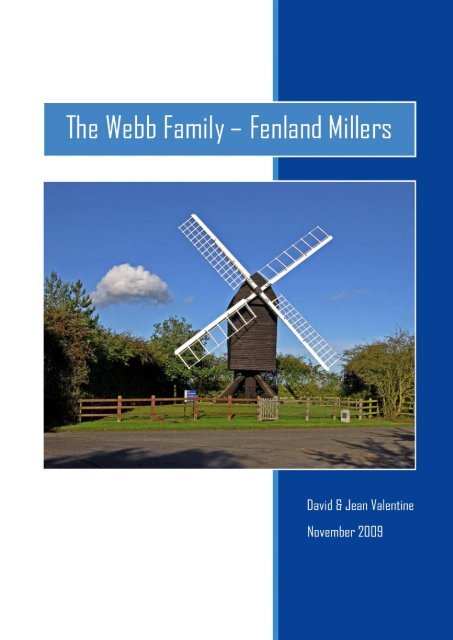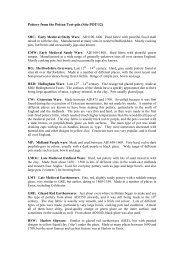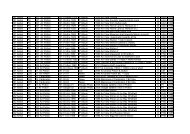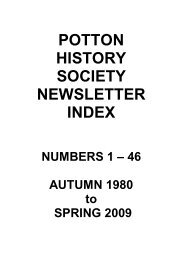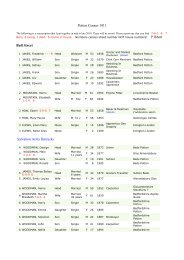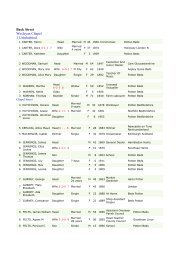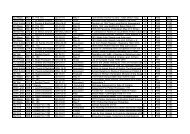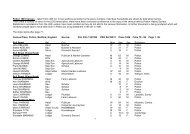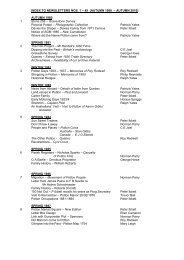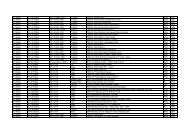Charles John Webb - Potton History Society
Charles John Webb - Potton History Society
Charles John Webb - Potton History Society
Create successful ePaper yourself
Turn your PDF publications into a flip-book with our unique Google optimized e-Paper software.
Introduction<br />
W<br />
hilst researching the history of the <strong>Webb</strong> family it<br />
was interesting that during the 1700’s and 1800’s,<br />
the occupation Miller and/or Baker featured<br />
prominently throughout the generations. In the 1700’s there<br />
were <strong>Webb</strong> millers recorded throughout Cambridgeshire and in<br />
the 1800’s also recorded in Huntingdonshire, Bedfordshire,<br />
Lincolnshire and Hertfordshire.<br />
Often where the father was a miller other members of his family<br />
followed in his footsteps, sometimes working with their father<br />
before moving to a mill of their own or taking over the mill when<br />
father retired or died. Sometimes where older brothers were<br />
working in the mill the younger siblings worked as bakers in the<br />
family bake house, sometimes working as millers in later life or<br />
continuing as bakers.<br />
The mill was an integral part of village life and the miller an<br />
important member of the community. The mill was often leased<br />
from the Lord of the Manor although in some cases the miller<br />
owned the mill.<br />
After World War 1 the demise of the Windmill was rapid. As<br />
steam power developed, the uncertain power of the wind<br />
became less and less economical, and we are left today with a<br />
tiny fraction of the elegant structures that once extracted power<br />
from the wind.<br />
Today, thanks to restoration and preservation throughout the<br />
country, it will be possible for future generations to enjoy the<br />
sight of these magnificent windmills and enjoy their history.<br />
Most villages had a mill to grind corn and in the 1700’s and<br />
1800’s generations of the <strong>Webb</strong> Family were Millers on the<br />
Fens. It is almost certain that before Stephen <strong>Webb</strong> (b 1771) his<br />
Ancestors were also Millers.<br />
2
The <strong>Webb</strong> Family – Fenland Millers<br />
Stephen <strong>Webb</strong><br />
born 1771 in Croxton, Cambridgeshire<br />
Stephen was the step-brother of William (b 1782) and <strong>John</strong> (b 1791). In the 1861 census,<br />
aged 90, he was a Miller (presumably retired!) living in Toseland, Huntingdonshire. It was<br />
recorded that Stephen was a Miller at Toseland in 1847.<br />
William <strong>Webb</strong><br />
born 1782 in Eltisley, Cambridgeshire<br />
William was the brother of <strong>John</strong> (b 1791) and step-brother of Stephen (b 1771). In 1851<br />
William was a Miller and lived with his wife, Sophia (nee Fletcher) and their daughter<br />
Elizabeth at a cottage in Mill Street, Gamlingay, Cambridgeshire.<br />
<strong>John</strong> <strong>Webb</strong><br />
born 1791 in Gamlingay, Cambridgeshire<br />
<strong>John</strong> was the brother of William (b 1782) and step-brother of Stephen<br />
(b 1771). In 1841 <strong>John</strong> was a Miller and lived with his wife Esther (nee<br />
Cross) and their children at Croxton Mill, Cambridgeshire (pictured<br />
right). In the census of that year it was recorded that his son Joseph (b<br />
1825) was also a Miller at the mill.<br />
Thomas <strong>Webb</strong><br />
born 1812 in Eltisley, Cambridgeshire<br />
Thomas was the son of <strong>John</strong> (b 1791). In 1841 Thomas<br />
lived with his second wife Jemima (nee Docwra) and<br />
family in Eltisley and was a Baker. By 1851 the family<br />
had moved to Orwell, Cambridgeshire where they lived<br />
in Orwell Street. In the census of that year Thomas was<br />
described as a Baker’s Man. From 1854 the family lived<br />
in Great Gransden, Huntingdonshire (pictured left)<br />
where Thomas was the Miller and also a Farmer of 12<br />
acres. They lived at the Mill House. It is recorded that they were still living at the Mill House<br />
in the 1871 & 1881 censuses.<br />
3
THE LEGEND OF GREAT GRANSDEN MILL<br />
Legend tells how Mrs <strong>Webb</strong>’s brother died at the Mill House and among his belongings was<br />
found an “Infidel’s Bible”. Mrs <strong>Webb</strong> wanted to destroy it but her husband, who said he<br />
would take it into the town to sell it, hid it in the mill and forgot about it.<br />
The mill suddenly stopped working and remained idle for three years though Millwrights<br />
could find nothing wrong with it. The miller became almost bankrupt.<br />
Then a grandson came to live with the <strong>Webb</strong>s, heard the story, found the book in the mill<br />
and his grandmother burnt it. At once the mill began to turn, slowly at first but increasing in<br />
speed as the book was gradually destroyed.<br />
William <strong>Webb</strong><br />
born 1821 in Eltisley, Cambridgeshire<br />
William was the son of <strong>John</strong> (b 1791) and the<br />
brother of Thomas (b 1812), Joseph (b 1825) and<br />
<strong>Charles</strong> <strong>John</strong> (b 1834). In 1851 William lived in a<br />
Tenement in Main Road, Toft, Cambridgeshire<br />
where he was a Miller at Toft Windmill (pictured<br />
right), employing one man, his brother <strong>Charles</strong><br />
<strong>John</strong> who was also a Journeyman Miller. By 1861<br />
William and his wife Elizabeth had moved to<br />
Chapel Lane, Langford, Bedfordshire and by 1871 he was a Miller at Ellington,<br />
Huntingdonshire.<br />
Joseph <strong>Webb</strong><br />
born 1825 in Eltisley, Cambridgeshire<br />
Joseph was the son of <strong>John</strong> (b 1791) and brother of Thomas (b 1812), William (b 1821) and<br />
<strong>Charles</strong> <strong>John</strong> (b 1834). By 1851 Joseph had taken over as Miller at Croxton Mill from his<br />
father and lived there with his wife Eliza (nee Harradine) until sometime before 1858. By<br />
1858 the family had moved to Emneth, Norfolk<br />
where they lived at Gaultree where Joseph was a<br />
Master Miller. From 1858 until 1865 Joseph was<br />
Miller at both Emneth smock mill and Emneth<br />
tower mill. On the 1871 census Joseph was a<br />
Miller & Baker in Pinchbeck West, Lincolnshire.<br />
After Outwell smock mill, Cambridgeshire<br />
(pictured left) was advertised for let in 1876;<br />
4
Joseph became the Miller until it was put up for let again in 1881. He<br />
was unemployed at the time of the 1881 census. The 1891 census<br />
sees the family living at 5 Norfolk Street West and he was Miller at<br />
Wisbech Leach’s Mill, Cambridgeshire (pictured right). From 1892<br />
until his death in 1897 he was a Miller at Christchurch Drake’s Mill<br />
with his son Ebenezer (b 1868) until Joseph’s death in 1897.<br />
Following are excerpts from the Emneth entry in “Norfolk Mills” (www.norfolkmills.co.uk).<br />
To be Sold by Auction by Mr Thomas Hodson at the Queens Head, Emneth in the County of<br />
Norfolk on Thursday the 18th October 1863 at six for seven o'clock in the evening. All that<br />
Freehold Brick Tower Corn Windmill with Patent Sails, 3 pairs Stones & other going gear<br />
complete, situate in the centre of Emneth Gaultree next the public highway & also that Dwelling<br />
House & Shop with Bake house & oven, Stable & other outbuildings & all that newly erected<br />
Cottage near adjoining, together with about 30 acres of land & garden ground upon which the<br />
mill & house are built, situate at the Gaultree aforesaid next the highway south & west, the<br />
cottage & land of <strong>John</strong> Jenkinson north & the Queens Head east.<br />
Wisbech, 21.9.1863<br />
G. & F. M. Metcalf<br />
Solicitors. Wisbech<br />
Wisbech Advertiser - 21st September 1863<br />
To be Sold by Auction by Mr Thomas Berry at the Public Hall, Wisbech on 24 September 1874 at 3<br />
o'clock in the afternoon precisely. Brick Tower & Wind Corn Mill with Patent Sails, 2 pairs French<br />
Stones & one pair grey stones, cylinder, Dressing machine & other going gear complete, situate in<br />
the middle of Emneth Gaultree next the public highway, & all that Dwelling House. The above<br />
premises are now in the occupation of Mr. Thomas King.<br />
F. M. & F. Metcalfe<br />
Wisbech Advertiser - 8th September 1874<br />
“It was reported that the Miller claimed that the building of the new school house robbed him of<br />
his wind. Presumably this was the National School built in 1859.<br />
The Miller at the time was Joseph <strong>Webb</strong>.”<br />
5
<strong>Charles</strong> <strong>John</strong> <strong>Webb</strong><br />
born 1834 in Croxton, Cambridgeshire<br />
<strong>Charles</strong> <strong>John</strong> was the son of <strong>John</strong> (b 1791) and brother of Thomas (b 1812), William (b 1821)<br />
and Joseph (b 1825). In 1851 <strong>Charles</strong> was a Journeyman Miller, working with his brother<br />
William at Toft Windmill.<br />
<strong>John</strong> <strong>Webb</strong><br />
born 1839 in Bourn, Cambridgeshire<br />
<strong>John</strong> was the son of Thomas (b 1812) and brother of William Jabez (b 1850) and Stephen (b<br />
1856). In 1861 <strong>John</strong> was a Baker at his father’s Mill and Bake House at Great Gransden Mill.<br />
By 1871 he and his wife Harriet (nee Lunniss) had moved to Hertfordshire where they lived<br />
at 2 Vine Cottages, Stapleford where <strong>John</strong> was a Miller. It is also documented that in 1877<br />
<strong>John</strong> was a Miller in Kimbolton, Huntingdonshire. Before 1891 the family had moved to<br />
Ashwell, Hertfordshire where <strong>John</strong>, on the census of that year, was again a Miller and a<br />
Baker & Bread Maker on the 1901 census.<br />
William Jabez <strong>Webb</strong><br />
born 1850 in Orwell, Cambridgeshire<br />
William Jabez was the son of Thomas (b 1812) and brother of <strong>John</strong> (b 1839). William was a<br />
Miller at Great Gransden in 1871, moving with his wife Jane (nee Hodge) before 1881 to<br />
Gilston, Hertfordshire where he was a Miller. The family returned to Great Gransden before<br />
1891 to take over as Miller from his father Thomas and moved into the Mill House. William<br />
Jabez was Miller at Great Gransden until his death in 1912.<br />
William <strong>John</strong> <strong>Webb</strong><br />
born 1852 in Croxton, Cambridgeshire<br />
William <strong>John</strong> (pictured left) was the son of Joseph (b 1825) and brother<br />
of Ebenezer (b 1868). In 1881 William lived at Holbeach Hurn Bank<br />
with his first wife Elizabeth Ann (nee Love) and was a Corn Miller. In<br />
1886, after Elizabeth’s death, he married Rose Ellen Frances (nee<br />
Smith) in 1890. By the following year, 1891 the family had moved to<br />
Moulton, Lincolnshire where William was the Miller. The 1891 census<br />
describes him as a Life Assurance Agent. Whether his change in<br />
employment was due to repair to the storm damage to the sails in<br />
1894 or the mill being taken over is uncertain, but by the 1911 census<br />
6
William was the Miller again. His<br />
second wife, Rose Ellen Francis (nee<br />
Smith) owned a Grocers & Drapers<br />
Shop in Moulton. The photo (right)<br />
was taken circa 1908 and shows<br />
Rose Ellen in the shop doorway with<br />
some of her children. One of<br />
William’s sons, George, from<br />
William’s first marriage, married<br />
Rose Ellen (nee Minns) and moved<br />
from Theddlethorpe, Lincolnshire to<br />
Salford, Manchester (see Bakers section). In 1940, their youngest daughter, Doris, married<br />
Frederick Exton. Fred was a Miller at the Hovis factory in Trafford Park, Manchester, as was<br />
his father William.<br />
Stephen <strong>Webb</strong><br />
born 1856 in Great Gransden, Huntingdonshire<br />
Stephen was the youngest son of Thomas (b 1812) and brother of <strong>John</strong><br />
(b 1839) and William Jabez (b 1850). In 1881 Stephen was a Miller at his<br />
father’s mill in Great Gransden and lived at the Mill House. By 1891 he<br />
had moved with his wife Ann Severina (nee Munton) and son to Jubilee<br />
Row in Eaton Soton, Bedfordshire (pictured left) where he was the<br />
Miller. The 1911 census reports that he was a Miller living in Walsoken,<br />
Wisbech.<br />
Ebenezer <strong>Webb</strong><br />
born 1868 in Pinchbeck, Lincolnshire<br />
Ebenezer was the son of Joseph (b 1825) and the brother of William<br />
<strong>John</strong> (b 1852). In 1891 Ebenezer was a Miller at Wisbech Leach’s Mill<br />
with his father Joseph. From 1892 until 1900 and again in 1903 he was<br />
a Miller at Christchurch Drake’s Mill, Wisbech, again with his father<br />
until Joseph’s death in 1897. The 1911 census recorded Ebenezer and<br />
his wife, Leah Kate (nee Ramm) and children; living at Poulter’s Drove,<br />
Upwell, Norfolk where he was a Miller at Upwell Mill (pictured right).<br />
7
William Edwards <strong>Webb</strong><br />
born 1871 in Great Gransden, Huntingdonshire<br />
William was the son of William Jabez (b 1850) and brother of Stephen<br />
Docwra (b 1873) and Aubrey Lemuel (b 1878). In 1891 he was living in<br />
Hitchin Street, Biggleswade, Bedfordshire with his future in-laws and was<br />
a Miller at Franklin’s Mill, Biggleswade (pictured left). After his marriage<br />
to Fannie Jane (nee Peacock) in 1894 he continued to live in Hitchin<br />
Street as a Miller. The 1901 and 1911 censuses confirmed that the family<br />
were still at the same address and William was still a Miller.<br />
Stephen Docwra <strong>Webb</strong><br />
born 1873 in Great Gransden, Huntingdonshire<br />
Stephen Docwra was the son of William Jabez (b<br />
1850) and brother of William Edwards (b 1872)<br />
and Aubrey Lemuel (b 1878). In 1891 Stephen was<br />
lodging at St Mary’s Street, Eynesbury,<br />
Huntingdonshire where he was a Miller Improver.<br />
Stephen was the Miller at <strong>Potton</strong> from 1899 until<br />
the mill closed in 1932. He lived with his wife<br />
Lizzie (nee Sherman) and family at the Windmill,<br />
Mill Road, <strong>Potton</strong>, Bedfordshire (pictured right).<br />
Aubrey Lemuel <strong>Webb</strong><br />
born 1878 in Great Gransden, Huntingdonshire<br />
Aubrey Lemuel was the youngest son of William Jabez (b 1850) and the brother of William<br />
Edwards (b 1872) and Stephen Docwra (1873). The 1901 census shows Aubrey working as a<br />
Miller in his father’s mill at Great Gransden and the 1911 census confirms he was still at the<br />
Mill. At the outbreak of the First World War Aubrey joined the 2nd Battalion, Bedfordshire<br />
Regiment. Private 20077 Aubrey Lemuel <strong>Webb</strong> was killed in action on 28th March 1918. He<br />
is commemorated on the Great Gransden War Memorial (although the date of his death is<br />
wrongly inscribed as 29th March 1918) and also on the Pozieres Memorial at the Pozieres<br />
British Cemetery, Ovillers-la-Boisselle, Somme, France.<br />
8
The <strong>Webb</strong> Family – Bakers<br />
Richard Lunniss <strong>Webb</strong><br />
born 1864 in Long Stowe, Cambridgeshire<br />
Richard Lunniss was the son of <strong>John</strong> (b 1839) and brother of Thomas <strong>John</strong> (b 1866), Ulysses<br />
Docwra (b 1872) and Albert Edward (b 1875). Before the 1891 census Richard had moved to<br />
Shefford, Bedfordshire where he and his wife Louisa Rebecca (nee Willis) lived and traded as<br />
a Baker & Grocer. In 1901 the census described Richard as a Baker & Shopkeeper and the<br />
1911 census as a Baker and Mealman (a dealer in meal or flour).<br />
Thomas <strong>John</strong> <strong>Webb</strong><br />
born 1866 in Long Stowe, Cambridgeshire<br />
Thomas <strong>John</strong> was the son of <strong>John</strong> (b 1839) and brother of Richard Lunniss (b 1864), Ulysses<br />
Docwra (b 1872) and Albert Edward (b 1875). In 1891 Thomas was a Baker working with his<br />
father, the Miller, at Ashwell, Hertfordshire. After getting married in 1893 to Harriet (nee<br />
Smart), they moved to Luton, Bedfordshire. In the 1901 census he was a Baker & Grocer at<br />
65 Burr Street, Luton. By 1911 the family had moved to 197 Dunstable Road, Luton where<br />
Thomas was described in the census as a Baker and Confectioner.<br />
Rose Ellen <strong>Webb</strong> (nee Minns)<br />
born 1871 in Morrower, Cambridgeshire<br />
In 1905, Rose Ellen married George<br />
<strong>Webb</strong> (b 1880 in Holbeach Hurn,<br />
Lincolnshire), son of William <strong>John</strong> (b<br />
1852), and lived in Theddlethorpe,<br />
Lincolnshire. In 1912 Rose Ellen,<br />
George and their family moved to<br />
Salford, Manchester, where Rose Ellen<br />
opened a Baker’s and Confectionery<br />
shop at 216 Tatton Street, Salford.<br />
Pictured left is Rose Ellen stood in the<br />
doorway of the shop in 1913.<br />
9
Ulysses Docwra <strong>Webb</strong><br />
born 1872 in Kimbolton, Huntingdonshire<br />
Ulysses Docwra was the son of <strong>John</strong> (b 1839) and brother of Richard Lunniss (b 1864),<br />
Thomas <strong>John</strong> (b 1866) and Albert Edward (b 1875). Ulysses was an Assistant Baker working<br />
in his brother Richard Lunniss’ Baker’s shop in Shefford, Bedfordshire. After his marriage to<br />
Laura Mary J (nee Clark) in 1894 he owned his own Bakers shop in Bowes Park, Southgate,<br />
Middlesex and on the 1901 and 1911 censuses was still living and trading there.<br />
Albert Edward <strong>Webb</strong><br />
born 1875 in Kimbolton, Huntingdonshire<br />
Albert Edward was the son of <strong>John</strong> (b 1839) and brother of Richard Lunniss (b 1864),<br />
Thomas <strong>John</strong> (b 1866) and Ulysses Docwra (b 1872). In 1901 he was a Baker in his brother<br />
Ulysses’ Baker’s shop in Bowes Park, Southgate, Middlesex. In 1902 he married Gertrude<br />
(nee Walker) and by 1911 he and his wife and son lived at 7 The Exchange, Brighton Road,<br />
Croydon, Surrey where he had his own Baker’s shop.<br />
Walter <strong>Webb</strong><br />
born 1877 in Gedney, Lincolnshire<br />
Walter was the son of William <strong>John</strong> (b 1852) and brother of Herbert (b 1884). In 1891<br />
Walter was an Apprentice Baker living in Church Lane, Balderton, Newark, Nottinghamshire<br />
with William Coddington, the Baker, and his wife. By 1901 Walter was still working and living<br />
at the same address, where he was now a Baker. In 1906 he married Louisa (nee Wild) and<br />
by 1911 he had his own Bakers at 8 Queen’s Road, Newark.<br />
Herbert <strong>Webb</strong><br />
born 1884 in Holbeach Hurn, Lincolnshire<br />
Herbert was the son of William <strong>John</strong> (b 1852) and brother of Walter (b 1877). Herbert and<br />
his first wife Frances (nee Burton) lived in Whaplode, Lincolnshire where he was a Baker.<br />
10
English Windmills<br />
W<br />
indmills appeared in England from c.1180 with earlier references to "mills" (such<br />
as in the 11th century Doomsday Book) generally held to be talking about either<br />
animal or water powered mills. The 14th and 15th centuries provide evidence of<br />
what the early mills looked like, with illustrations being seen in stained glass and wood<br />
carvings, in addition to manuscript records. These early illustrations all show the simple, all<br />
wooden, post mill structure. A fixed structure would only work if the wind was blowing in<br />
the right direction, so the post mill, which could be turned into the wind, was the preferred<br />
design. They were often sited high or built on a raised mound to catch more wind. A logical<br />
development by the end of the Middle Ages was the tower mill. The tower gave height, and<br />
only a cap holding the sails revolved. Smock mills, which arrived by the late 16th century,<br />
are similar, but entirely timber-built, whereas the tower type was built of durable brick or<br />
stone, so more tower mills survive. Windmills were favoured in the windy flatlands of East<br />
Anglia and watermills in upland areas, with fast-running rivers and streams.<br />
Post Mills<br />
Post mills are so named because of the large upright<br />
post on which the mill's main structure (the "body" or<br />
"buck") is balanced. By mounting the body this way, the<br />
mill is able to rotate to face the (variable) wind<br />
direction.<br />
To maintain the upright post, a structure consisting of<br />
horizontal crosstrees, and angled quarterbars is used. By<br />
far the most common arrangement was 2 cross bars at<br />
right angles to each other under the base of the post, together with 4 quarterbars.<br />
Occasionally however other arrangements did occur, such as 3 crosstrees, and consequently<br />
6 quarterbars.<br />
Initially the crosstrees would have rested directly on the ground, (or indeed were buried in<br />
the ground for extra stability) but since this makes them very susceptible to rotting, the<br />
crosstrees were soon being placed on brick piers, to raise them off the ground.<br />
The body of the mill housed all the milling machinery - a large brake wheel on the same<br />
shaft as the sails (the "windshaft") transferred power to a smaller gear at right angles to it,<br />
called the wallower. The wallower shared a vertical shaft with the great spur wheel, and<br />
from this smaller wheel a "stone nut" was used to drive the millstone. As larger mill bodies<br />
were constructed, additional pairs of stones could be driven, by taking further power taps,<br />
each using an extra "stone nut" off the great spur wheel. In order to apply some level of<br />
control to the mill, the brake wheel could be slowed using a large wooden friction brake<br />
around its outer edge.<br />
11
As already mentioned, the whole body rotated on the central post, in order to face the<br />
wind. To allow this to happen, a tailpole or tiller beam extended from the rear of the body.<br />
By pushing on this beam (or by using some form of winch or animal power) the miller<br />
rotated his mill. The tailpole also provides a useful attachment point for a ladder to provide<br />
access to the mill.<br />
An obvious improvement on the early post mill is to build a roundhouse up around the<br />
crosstrees and quarterbar structure. This makes this structure a lot more protected from the<br />
weather, and provides additional storage space.<br />
Smock Mills<br />
Smock mills (named after the dress like agricultural costume whose<br />
shape they vaguely resemble) are a fundamental improvement over<br />
the post mill design.<br />
Instead of rotating the whole body of the mill to face the mill, the<br />
smock mill design consists of a fixed wooden body, holding the milling<br />
machinery, together with a rotatable cap, which holds just the roof,<br />
the sails, the windshaft and the brake wheel.<br />
By rotating just the mill cap, the body of the mill can be made much larger than in a post<br />
mill, and hence able to house more pairs of stones, and more ancillary machinery. In<br />
addition, the body can be made arbitrarily high, the extra height allowing the sails to catch<br />
more wind (and to a certain extent a taller body can allow longer sails to be employed, to<br />
the same end).<br />
Smock mill bodies are theoretically roughly circular, though the use of straight timber<br />
means that most are actually eight sided. Other numbers of sides occur, including in England<br />
examples of six through to twelve sides. (In addition there are a number of small smock<br />
mills throughout the world which have square bodies). Many English smock mills are<br />
constructed above a more substantial brick built base, which may range from a few courses,<br />
up to several stories high.<br />
Tower Mills<br />
Tower mills take the smock mill design even further, by replacing the<br />
wooden body with a brick or stone built tower. Since the necessity of<br />
having straight sides (due to straight timber) is removed, true circular<br />
bodies are the common arrangement. However straight sided<br />
structures do occur, and even towers that start off with straight sides<br />
at the base, but change to a circular plan part way up (perhaps due to<br />
building the tower on what was originally a smock mill base).<br />
By using brick or stone for the body, tower mills can be built even<br />
larger and taller than smock mills, and by being a more durable building material, the mills<br />
are more weatherproof, and more fireproof.<br />
12
About the Authors<br />
David and Jean Valentine have, for the past 12 years, lived on the Isle<br />
of Wight. Originally both born in Manchester they and their family<br />
have also lived in Suffolk and Oxfordshire.<br />
Their interest in the family history of the <strong>Webb</strong> family was through<br />
Jean’s mother, Doris Exton (nee <strong>Webb</strong>) who was born in<br />
Theddlethorpe, Lincolnshire in 1910. Doris was the daughter of<br />
George <strong>Webb</strong> who was a Wheelwright and Rose Ellen (nee Minns).<br />
Doris’s grandfather (Jean’s great grandfather) was William <strong>John</strong><br />
<strong>Webb</strong> (b 1852) who was the miller at Moulton, Lincolnshire.<br />
Their research into the history of Jean’s ancestry highlighted the<br />
number of millers in the <strong>Webb</strong> family so this project was undertaken.<br />
It is on-going so as new information becomes available this article on<br />
The <strong>Webb</strong> Family – Fenland Millers will be updated.<br />
Copyright David & Jean Valentine 2009<br />
13


